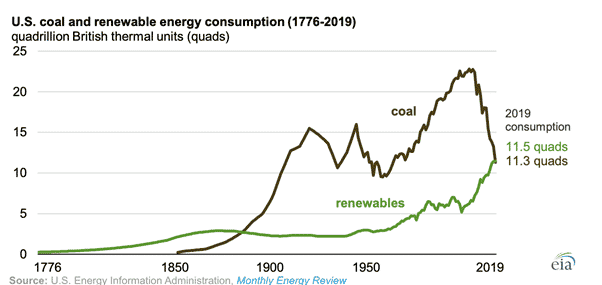Renewables Exceed Coal in U.S. for the First Time in Over a Century: EIA

U.S. annual energy consumption from renewables reached 11.5 quadrillion British thermal units in 2019, surpassing coal for the first time since before 1885, according to a May 28 report from the U.S. Energy Information Administration. The agency pointed to the growth of renewable energy, especially wind and solar energy, for electricity generation amid the continued decline of coal use over the past decade.
- In 2019, U.S. coal consumption for power generation decreased for the sixth straight year to 11.3 quadrillion British thermal units, the lowest level in 42 years; coal use dropped almost 15 percent from 2018, while the total renewable energy consumption grew by 1 percent over the same time period.
- Wind and solar are the largest contributors to the growth in renewable energy in the U.S. since 2015; wind surpassed hydro last year and is currently the most-used source of renewable energy for electricity generation on an annual basis.
- Currently, 90 percent of U.S. coal consumption is in the power sector, with most of the remainder used in the industrial sector.
- While commercially delivered renewable energy is more broadly consumed by electricity generation, accounting for 56 percent, industrial and transportation sectors represent 22 percent and 12 percent, respectively; the residential sector consumes 7 percent, while the commercial sectors uses 2 percent.
- Natural gas consumption has seen significant growth as it has replaced much of the retired coal-fired generation capacity
EnerKnol Pulses like this one are powered by the EnerKnol Platform—the first comprehensive database for real-time energy policy tracking. Sign up for a free trial below for access to key regulatory data and deep industry insights across the energy spectrum.
ACCESS FREE TRIAL